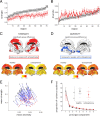Functional connectivity and brain networks in schizophrenia
- PMID: 20631176
- PMCID: PMC2914251
- DOI: 10.1523/JNEUROSCI.0333-10.2010
Functional connectivity and brain networks in schizophrenia
Abstract
Schizophrenia has often been conceived as a disorder of connectivity between components of large-scale brain networks. We tested this hypothesis by measuring aspects of both functional connectivity and functional network topology derived from resting-state fMRI time series acquired at 72 cerebral regions over 17 min from 15 healthy volunteers (14 male, 1 female) and 12 people diagnosed with schizophrenia (10 male, 2 female). We investigated between-group differences in strength and diversity of functional connectivity in the 0.06-0.125 Hz frequency interval, and some topological properties of undirected graphs constructed from thresholded interregional correlation matrices. In people with schizophrenia, strength of functional connectivity was significantly decreased, whereas diversity of functional connections was increased. Topologically, functional brain networks had reduced clustering and small-worldness, reduced probability of high-degree hubs, and increased robustness in the schizophrenic group. Reduced degree and clustering were locally significant in medial parietal, premotor and cingulate, and right orbitofrontal cortical nodes of functional networks in schizophrenia. Functional connectivity and topological metrics were correlated with each other and with behavioral performance on a verbal fluency task. We conclude that people with schizophrenia tend to have a less strongly integrated, more diverse profile of brain functional connectivity, associated with a less hub-dominated configuration of complex brain functional networks. Alongside these behaviorally disadvantageous differences, however, brain networks in the schizophrenic group also showed a greater robustness to random attack, pointing to a possible benefit of the schizophrenia connectome, if less extremely expressed.
Figures






References
-
- Achard S. Brainwaver. Software package. 2007 Retrieved on November 30, 2009 from http://cran.r-project.org/
-
- Achard S, Bassett DS, Meyer-Lindenberg A, Bullmore E. Fractal connectivity of long-memory networks. Phys Rev E Stat Nonlin Soft Matter Phys. 2008;77 036104. - PubMed
-
- American Psychiatric Association. Diagnostic and statistical manual of mental disorders. Ed 4. Washington, DC: American Psychiatric Association; 2000. text revision.
Publication types
MeSH terms
Grants and funding
LinkOut - more resources
Full Text Sources
Other Literature Sources
Medical
